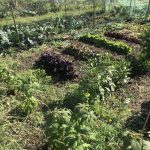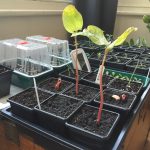Everyone is talking about the weather as though we haven’t only just entered mid-Summer. Don’t allow a few rainy days after a prolonged heatwave trick you into thinking it’s autumn when we have at least another 6 – 8 weeks of warm weather to go. And certainly where we are in London, I can see the plants responding to the more preferable weather.
There’s a term that clicked with me when studying at the Royal Botanic Garden Edinburgh: the law of limiting factors. Plants grow fastest when they hit their preferred equilibrium of inputs. The closer a plant gets to that equilibrium the faster it will grow. Inputs for plants are many including water, temperature, light, macro and micro nutrients, humidity and the various gases around them above and below ground, especially carbon dioxide and oxygen.
As we move into spring and summer, light levels, day length and temperatures increase which for most plants means an increase of inputs leading to rapid growth. We can fuel that as gardeners by adding fertilisers, watering, reducing shade etc. However, the law of limiting factors states that no matter how plentiful various inputs are, if even just one is inadequate, it holds the effects of the whole lot back. For instance, a plant can have as much sun and water as it likes but without enough nutrients in the soil, it won’t grow at its optimum rate.
Often we see a garden crescendo in mid-summer as all conditions tend to be at their best, but for most of us this year it strangely didn’t happen due to the heatwave and drought. In fact my dependable dahlias and salvias, which I expected to love the soaring temperatures and light, simply stalled, looking worse than I’ve ever seen them. Despite the fact I was watering them heavily to make up for the drought.
Yet since temperatures dropped slightly and we’ve had rain, growth – after a brief pause for the plants to collect themselves – has begun to erupt. Dahlias noticeably have finally started bursting into flower and new leaves are growing with aplomb (I never use the word aplomb lightly). Even the salvias have started a new flush of leafy growth leading, no doubt, to the flowers I’ve missed.
So… why, when they had more sunlight and warmth than ever, and I was watering and feeding them did their growth stall and struggle?
It’s the law of limiting factors, or could I even say, the law of excessive factors. I don’t know exactly what the problem was but it will have to have been either: inconsistent watering, lack of water reaching lower roots, too much sun, too much heat or a lack of humidity. Quite likely a mix of all of these things.
Obviously something was going quite wrong everywhere because a large number of my plants were clearly struggling with transporting nutrients around their stems. I saw nettles succumb first everywhere to the drought, crisping up. My tomatoes on the allotment, planted in the ground, suffered blossom end rot which has now righted itself with the rains and cooler weather. Their leaves too curling. This is an obvious sign that they were struggling with nutrient transport in the heatwave as calcium failed to reach the fruit in sufficient quantities.
Quite suddenly all of these plants struggling have raced back into health. In the first week following the rains, this wasn’t evident but sure enough the plants would have been bursting into growth on that first day, just on a microscopic level as meristems started producing cells faster. Now we can see it.
The two month drought here in London was a genuine struggle and allotment, garden and my client’s gardens have suffered. That said, now we’re through it, looking back it is very interesting how various plants reacted. Even more so as the law of limiting factors was so evident everywhere and in some unexpected ways. We are now through it and don’t be fooled by those drought-dropped leaves everywhere. It is not autumn yet, as much as I look forward to that season, we are still in summer.
Nights may be drawing in but that allows for those precious warm nights, sitting out after sunset with a tea or wine swaddled in nightfall and cosiness. Beautiful evenings we only experience from mid-summer onwards. Don’t feel limited by the dwindling light, sometimes we and the plants can have too much of it.



